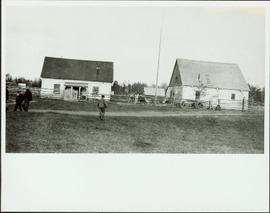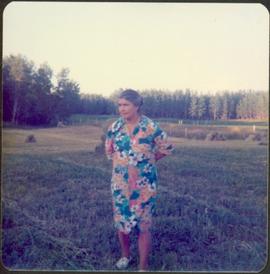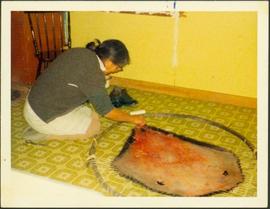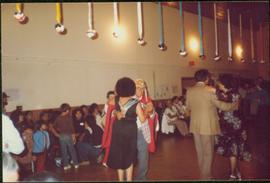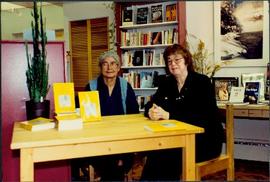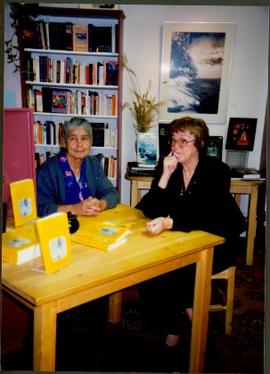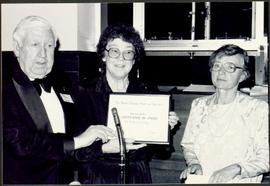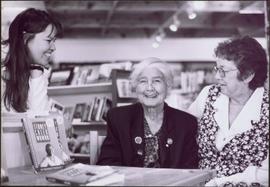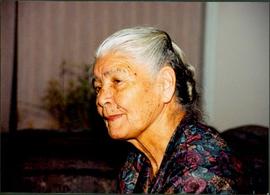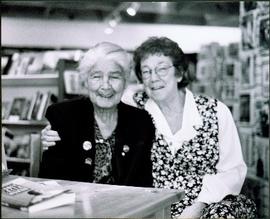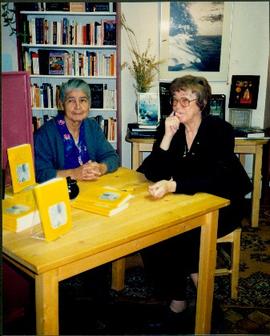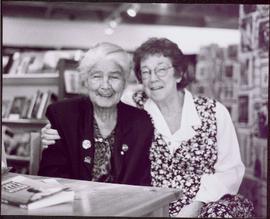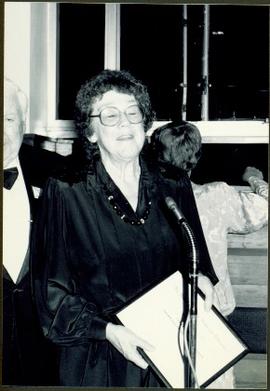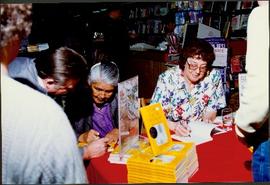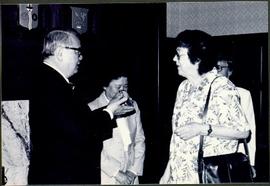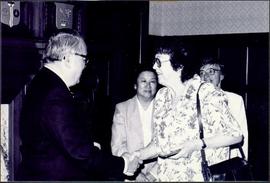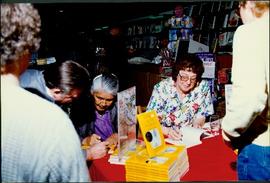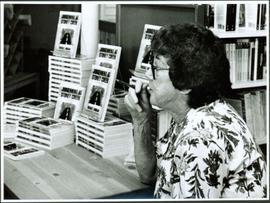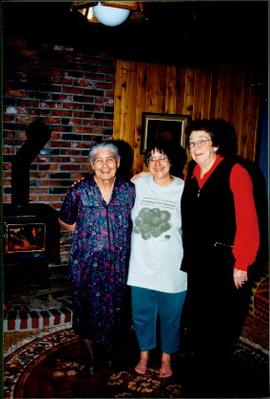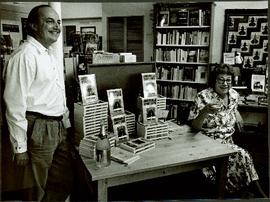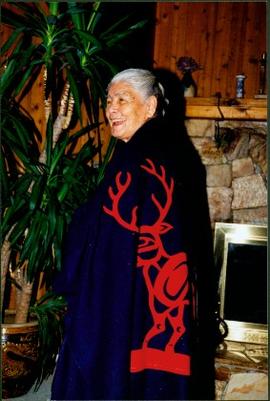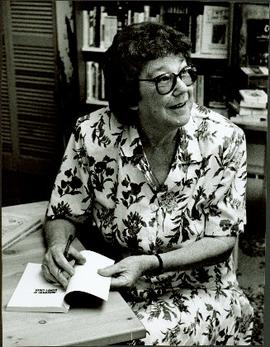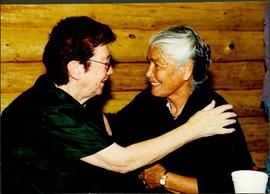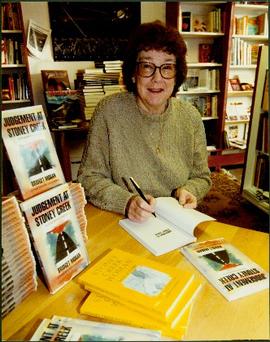Photograph depicts two buildings behind fence, sheds visible in background. Unidentified men can be seen walking in foreground. Small structures believed to be teepees can be seen behind fence.
This fonds illustrates Bridget Moran’s careers as a writer, a social worker and a social activist primarily within the Prince George region of British Columbia. This fonds also contains records pertaining to her personal relationships with family and friends and her receipt of various honours and awards.
Types of records reflective of her career as a writer include: published articles and unpublished manuscripts, drafts and front cover mock-ups, correspondence with editors from Arsenal Pulp Press, grant applications, notebooks, background material, writer’s workshop invitations and overviews, photographs, oral history interviews and transcripts, and VHS recordings of classroom talks given by Bridget Moran, Mary John and Justa Monk re: her publications.
Types of records reflective of her career as a social worker and social activist include: annual reports, work journals, correspondence and published newspaper articles re: social policy, photographs, and general background material. Correspondence, photographs and newspaper clippings highlight her personal relationships, while her receipt of honours and awards is demonstrated through copies of letters of recommendation, newspaper clippings, photographs, VHS recordings of award ceremonies, event itineraries, congratulatory correspondence, and invitations.
The Bridget Moran fonds has been divided into the following four series:
- Published and Unpublished Materials
- Career Related Materials
- Personal Papers and Correspondence
- Honours and Awards.
Series consists of newspaper clippings, correspondence, photographs, pamphlets, newsletters, advertisements, contracts, notebooks, audiocassettes of oral interviews and readings, transcripts, book launch announcements, front cover mock-ups, edited drafts, manuscripts, fact sheets, poems, catalogues, bookmarks, skits, conference events programme, poster, grant applications and related correspondence, a wooden placard, handwritten notes, book reviews, inquest reports, background material, VHS recordings of classroom talks given by Bridget Moran, Mary John and Justa Monk re: her publications, and ephemera. This series contains material from all five of her publications:
- (1988) Stoney Creek Woman: The Story of Mary John. Vancouver: Arsenal Pulp Press.
- (1990) Judgment at Stoney Creek. Vancouver: Arsenal Pulp Press
- (1992) A Little Rebellion. Vancouver: Arsenal Pulp Press.
- (1994) Justa: A First Nations Leader. Vancouver: Arsenal Pulp Press.
- (1996) Prince George Remembered. Prince George, British Columbia: Moran Publishing.
This series also consists of, but is not limited to, a number of unpublished manuscripts and drafts and/or writing contest submissions also written by Bridget Moran, such as:- "Mary and Me" (ca. 1998)
- "Where Winds Come Sweet" (ca. 1981)
- "The Horizontal Land" (ca. 1992)
- "The Summer of '81"
- "The Relief Cheque" (ca. 1998)
- "The Case of the Box of Matches" (ca. 1987)
- "Unholy Deadlock" (ca. 1990)
- "The Numbers Game"
- "Reflections on Theme" (ca. 1967)
- "Come Hell or High Water" (ca. 1976)
- "Man Alive"
- "The Deadbeat Mystique"
- "Hell on Wheels"
- "Backstairs at the Palace"
- "James MacCallum" (ca. 1984)
- "Hushaby, Baby" (ca. 1981)
- "The Decline and Fall of Mr. Sullivan"
- "Case History of a Gadfly"
- "Welfare and the Good Life"
- "Childhood Memories" (ca. 1976)
- "The Three Musketeers" (ca. 1974-75)
- "A Child's Christmas in Saskatchewan" (ca. 1979)
- "Diary of Success Homecoming"
- "My Old Flame" (ca. 1992)
- "O Ye Dry Bones" (ca. 1996)
- "Supper, Little Children" (ca. 1983).
File consists of Misc. typewritten notes under the following titles: the name "Nulki Lake," indian medicine, alcohol on reserve, housing on reserve, T.B. on reserve, indian agent, the Watchmen, the Church, alcohol, and families on Stoney Creek; typewritten notes under the following titles: early life, ancestors, Mary's childhood (racism), Mary's childhood (menstruation), Mary's childhood (the 1918 Flu), Mary's childhood (on the trapline), Mary's childhood (the trapline), Mary's childhood (her first coat), Mary's childhood (Christmas), and Mary's childhood (camping out and going to a Potlach); typewritten notes under the following titles: Mary's school days, childbirth, school life of Mary's kids, Mary's marriage, Lazarre's mother, marriage - housing, marriage - children, marriage - shopping in town, marriage - finances, marriage - work, work - depression, Indian Agent, marriage - hard work, camping, Lazarre's cabin at Wedgewood, doing hides, social life, whites, survival, Lazarre's family, Indian Agent and department of Indian Affairs, politics on reserve, citizen of the year, Catholic school, hides, potlach, siblings, net fishing, and changes; Lejac School: Thesis "And Then We Prayed" (pages 1 - 9) and questions for Mary.
File consists of:
- Newspapers include: The Georgia Straight, The Province; The Indian Voice; The Toronto Globe; The Vancouver Sun Weekend Magazine; The Vancouver Sun; The Citizen; and The Nechako Chronicle each featuring articles on the Thomas inquest.
- Report of inquiry as to cause of death of Faye Helen Huagen, Vanderhoof, B.C., December 27th, 1979.
- Copy of Canadian Welfare #5, Sept/Oct. 1974 issue.
- Copy of B.C. Police Commission report to Vanderhoof Mayor W.L. McLeod, November 1, 1976.
- Copy of letter from Helen Jones, Secretary of Stony Creek Indian Homemakers Club to the Honourable Garde Gardom, Attorney General of the Province of British Columbia regarding Richard Redekop (November 19, 1976).
- Draft version (includes annotations) of "Introduction" to Judgement at Stoney Creek sent to Bridget Moran from Mayo Moran, (Feb. 1990).
- Handwritten draft of a letter written to Vanderhoof Mayor Bill McLeod
- Copy of handwritten letter from Helen Jones [Secretary of Stony Creek Indian Homemakers Club] to Bridget Moran (?), November 22, 1976.
File consists of newspapers (all dated 1976) include: The Citizen; and The Nechako Chronicle featuring articles on the Thomas inquest. File includes the Nechako Chronicle, vol.60, no.26, Thursday July 1, 1976.
File consists of "My notes as free lance reporter at Press Table during the inquest into Coreen's death. September 24-27, 1976." [68 handwritten pages].
Item is a recording of an audio segment from CBC Radio in which a documentary update is provided on the inquest of Coreen Thomas.
Audiocassette Summary
Scope and Content:
- Update on the case of deceased Coreen Gay Thomas
- July 3, 1976 Coreen Thomas is struck and killed by a car walking out to the Stoney Creek Reserve
- Police Report blamed Coreen for causing the accident saying that she was involved in a game of chicken
- The Driver of the car, Mr. Redekopp, had a high blood alcohol content but was not blamed for the crash
- Indians claimed that they were frequently harassed on the road by white motorists
- An inquest occurred and focused on relations between Indians and Whites
- Redekopp, coroner, police detachment, federal department of Indian affairs all seemed to be on trial
- Vanderhoof residents state media coverage is sensational with Vanderhoof unfairly labeled as “the most racially troubled town in Canada”
- Some see problem as due to lack of activities for young people in small communities
- Stoney Creek Indians live in intolerable conditions
- Interview with Stoney Creek Reserve resident regarding sanitation problems; lack of proper sewage system; cases of tuberculosis; high rate of unemployment; she states DIA should be responsible and should come up with a solution
- Problem with the perception of an alcoholic society;
- Archie Patrick, FN leader talks about the prejudice, harassment and racism found in Vanderhoof and other Northern communities towards Native People
- Good things could come out of this inquest – Vanderhoof residents should learn about poor living conditions at Stoney Creek
- Reporter provides update on the inquest; that local Police were accused of intimidating the witnesses
- Coreen Thomas’ death was unnatural but accidental
- Redekopp was negligible because vehicle was going too fast
- Segment of interview with Harry Rankin on the Thomas’ inquest; questions on the state of fairness of the inquest; and the state of white-native relations in northern BC
- Inquest Findings: Measures that should be put into place: Upgrade emergency system in the area, no person be placed in morgue before death certificate is in issue, get resident doctor for hospital, breathalyzers taken as soon as is legally permitted, RCMP officers be encouraged to have parent or guarding present when questioning young people as witnesses, Stoney Creek Band Council and Vanderhoof Council work to establish a Friendship Centre
Documentary ends with interview of Sophie Thomas on need for a change in white-native relations – and ends with excerpt of music from the Vanderhoof ‘pioneer’ song.
End of Tape
File consists of:
- Newspapers (all dated 1976) include: The Times; The Citizen; The Sun; The Vancouver Sun; The Nechako Chronicle; Maclean's magazine
- Report titled: "A visit to Vanderhoof and Stoney Creek Reserve" by Remi J. De Roo, Chairperson, Human Rights Commission of British Columbia, September 24- 25, 1976
- Incomplete copy of "Departmental policy - resource implications manpower services to Native people" from P.S. Hall, Branch Manager CMC Vanderhoof to W.F.J. Osborne, Sr. Manager, CMC Prince George, dated July 20, 1976.
- Handwritten draft (?) of "Specimen Form of Verdict" supp.1/15/69
- Excerpt from article published in "Politics: National Indian Brotherhood"
- Report: "Inquest of Coreen Thomas, Vanderhoof, B.C. September 25, 26, 27, 28, 1976" submitted by Barbara Kobierski, Native Programs Section, Legal Services Commission.
File consists of 68 photographs and newspaper clippings. The newspaper clippings include "Bravo" (Time Colonist, Dec. 1, 1996) and "Bridget looks back into the eye of storm" (The Citizen, Feb. 21, 1983). The photographs consist of:
- [Entrance to] The Sanatorium - Fort Qu'Appelle, July 6, 1979
- [Trades Shop at] The Sanatorium - Fort Qu'Appelle, July 6, 1979
- Bridget Moran standing beside a log house [Mary John's house?]
- Mary John, portrait - profile
- Bridget Moran and Mary John with their arms on each others shoulders
- Mary John wearing a blanket (blue with red caribou on back)
- Mary John, unidentified woman (Mary John's daughter?) and Bridget Moran in Mary's home
- Justa Monk, and Bridget Moran side by side in a bookstore
- Bridget Moran and Mary John in embrace [photo courtesy of The Citizen newspaper]
- Dinner party featuring Bridget and seven unidentified woman sitting around a table
- Bridget Moran standing beside a car
- Bridget Moran standing in front of Metlakatla Fire Department sign
- Bridget Moran standing in front of Metlakatla Lake (?)
- Unidentified woman standing in front of Metlakatla Fire Department sign
- Unidentified woman standing in front of Alaska distance signage
- Bridget Moran standing outside of St. Paul's Anglican Church Learning Centre
- View of two buildings in midground and large mountain range in background
- View of boats tied at a dock on a lack with a mountain range in the background
- Bridget Moran working on her computer
- Bridget Moran on a small boat, a slight wake can be seen in the water in the background
- View of village in background, lake in foreground
- View of lake and mountains in background
- Dog beside Bulkley River waterfall and traditional fishing territory in Moricetown Canyon
- Bridget Moran sitting on bench beside Bulkley River waterfall and "Montier Booth" in Moricetown Canyon
- Nisga'a Government Administrative Building
- Bridget Moran and unidentified man standing outside Nisga'a Government Administrative Building
- Bridget and two friends having lunch in Newton
- Two women standing in a mall
- Three women posing together for photo
- Landscape perspective featuring cross country skiing trails and farm land
- Village on a bay
- Bridget Moran standing beside a decorative fruit platter featuring a carved elephant
- River and power lines
- Coloured map of Nisga'a Memorial Lava Bed Park
- Nisga'a Memorial Lava Bed Park (?)
- Bridget Moran at beginning of suspension bridge featuring a sign reading "Use of bridge at your own risk" Gitwinksihlkw Band Council
- Sign: "Moricetown Canyon Rules"
- Moricetown Canyon featuring Bulkley River waterfall and fishing territory
- Moricetown Canyon featuring Bulkley River waterfall and fishing territory
- Moricetown Canyon featuring Bulkley River waterfall and fishing territory
- Bridget Moran and unidentified man standing in front of new building
- Unidentified [new] building
- Bridget Moran coming out of Long House entrance
- Farmland landscape
- Justa Monk autographing Justa: a First Nations Leader at a book signing at Mosquito Books, Prince George
- Justa Monk and Bridget Moran autographing Justa: a First Nations Leader at a book signing at Mosquito Books, Prince George
- Justa Monk and Bridget Moran autographing Justa: a First Nations Leader at a book signing, Elders in background
- Justa Monk and Bridget Moran at a Justa: a First Nations Leader book signing at Mosquito Books, Prince George
- Justa Monk and Bridget Moran autographing Justa: a First Nations Leader at a book signing at Mosquito Books, Prince George, Paul Ramsay in background
- Bridget Moran at Mosquito Books, Prince George
- Justa Monk and Bridget Moran at a book signing at Mosquito Books, Prince George
- Justa Monk and Bridget Moran autographing Justa: a First Nations Leader at a book signing, Elder in background
- Justa Monk and Bridget Moran autographing Justa: a First Nations Leader at a book signing, Elder in background
- Bridget Moran and a group of three unidentified women
- Bridget Moran with a First Nations button blanket featuring thunderbird and killer whale designs
- Bridget Moran with a First Nations button blanket featuring killer whale design
- Bridget Moran outdoor portrait
- Bridget Moran indoor portrait
- Bridget Moran balcony portrait
- Justa Monk and Premier Mike Harcourt
- Bridget Moran in UNBC regalia for receipt of Honourary Law Degree (1995)
- Mary John and Bridget Moran at a book signing for Stoney Creek Woman
- Bridget Moran autographing Judgement at Stoney Creek at a book signing
- Bridget Moran with a First Nations button blanket featuring thunderbird, wolf and killer whale designs
- Mary John receiving the Order of Canada (1997) for outstanding service to her community
- Bridget Moran with Mike Harcourt, both wearing cowboy hats (colour laser copy)
- Mary John and Bridget Moran at a book signing for Stoney Creek Woman
- Mary John and Bridget Moran at a book signing for Stoney Creek Woman
- 27 colour negatives featuring a trip to Metlakatla and Moricetown
- Envelope containing 15 duplicate photographs
- 25 colour negatives featuring Justa book signing event at Mosquito Books.
Photograph depicts Mary John wearing flower print dress in cut field. Hay bales, trees, and fence in background.
Photograph depicts Mary John kneeling on floor while stretching hide. Chair and shoes in background.
Photograph depicts couples dancing in large room, crowd seated on chairs against wall in background. Ornaments are hung in a row from ceiling. Man dancing in centre wears traditional dress. Handwritten annotation on recto of photograph: "Elders gathering 1983".
File consists of:
- Press release and order form: "Tillacum Library announces the publication of Stoney Creek Woman: The Story of Mary John" (Winter 1989)
- Book launch invitation: "Tillacum / Pulp Press invite you to a book launching for Stoney Creek Woman by Bridget Moran
- Letter to Bridget Moran from Linda [Field], Tillacum Library (a division of Arsenal Pulp Press Book Publishers) re: formatting and editing of Stoney Creek Woman (June 21, 1988)
- News release for Stoney Creek Woman: The Story of Mary John by Bridget Moran
- Handwritten note featuring "Stoney Creek Woman" in the Carrier language
- Letter to Bridget Moran from John Matters re: Stoney Creek Woman (Jan. 25, 1989)
- Letter of acceptance to Bridget Moran from Linda Field re: publication of Stoney Creek Woman by Tillicum Library (May 26, 1988)
- Newspaper clipping re: news release of Stoney Creek Woman
- "A step or two in her moccasins" by Bridget Moran; a synopsis of Stoney Creek Woman; a Prologue of Stoney Creek Woman*"Pictures" - photograph key
- Book signing newspaper advertisement: "Bridget Moran & Mary John will once again be at Mosquito Books to autograph copies of Stoney Creek Woman"
- Publishers press release for Stoney Creek Woman: The Story of Mary John (Winter 1989)
- Memorandum sent to The Bulletin re: Bridget Moran's newly published book Stoney Creek Woman. (May 24, 1989)
- Handwritten note sent by Mary Ann [Lyall] to Bridget (?) re: strategic gifting of copies of Stoney Creek Woman
- Handwritten note sent to Oscar Bedard, Executive Director, Program Development, Ministry of Education from Bridget Moran re: Stoney Creek Woman (Jan. 4, 1989)
- Photographs: Elders' gathering, 1983, Mary John stretching a hide, Mary John in a flower print dress, standing in a field, Lazare in a kitchen serving ice cream to a little boy.
File consists of:
- "Past mistakes recorded in new book" (Vancouver Sun, May 8, 1995)
- "Murder led to election as tribal leader: social worker recorded story" (Vancouver Courier, Dec. 28, 1984)
- Transcript of "Harkins! Bob Harkins Comment" re: Justa publication (Monarch Broadcasting, Nov. 21, 1994)
- "Fascinating life, times of Justa Monk" (The Prince George Citizen, Feb. 2, 1995)
- "Justa: A Review" (Central Interior NDP News)
- "Blanket coverage" (B.C. Bookworld, spring 1995)
- "Manslaughter, then Justa for all" and "Blanket coverage" (B.C. Bookworld, spring 1995)
- Fax from Laura Boyd, Northwood Pulp & Timber to Justa Monk (and Bridget Moran?) re: names and positions of executive staff at Northwood (Nov. 14, 1994).
File consists of "A comparative list of general Indian and non-Indian Values" developed by Joann Sebastian Morris, revised 1987; "Making Indians in British Columbia" by Michael Kew, revised 1986; a photograph of "Fort George", courtesy of the Provincial Archives of British Columbia, Visual Records Division, Catalogue No. 96295; Negative No.: G-3097; Newspaper articles from The Prince George Citizen: "Indians behind bars: Figures are Shocking", "Commentary: Compensation Deal Attempt to Right Wrong"; British Columbia Heritage Series: Our Native Peoples: Dene (series 1, volume 9,) a Social Studies Bulletin published by the Department of Education, The Government of the Province of British Columbia, 1953.
Audio recording consists of an interview conducted by Bridget Moran with Mary John.
Audiocassette Summary
Scope and Content: Recording starts referring to this as a continuation of previous discussion. Mary John talks about fishing and refers to tools in Carrier language.
0’01” She talks about having her children and the use of midwives – and laying of hands by the mid- wives as a healing ritual. There were no doctors in area where Mary had all her children. Recalls in 1946 going to Vanderhoof to see a doctor for one of the more difficult births. Talks about use of mid-wives at Pinchi Lake mines when they [her husband and her worked at] cutting wood for the mines there
8’00” Mary John recalls coming to Fort George – living in tent camp near the tracks. Her Husband worked for a man named Koop
9’00” Mary talks about her children going to Lejac, the Indian residential school “they were lonely and we were lonely….there was silence….everyone [kids] were gone” She recalls that the dids didn’t come home for Christmas – left in September and came back in June. Talks about transport of the kids “big truck” came to get them in the fall to bring them to Lejac.
Mary discusses her own school life at Lejac in 1922 at age 7 – recalls her initial thoughts about going to school; being delivered to the school; remembers talking to her parents once on the telephone from Lejac and being very homesick. Describes where the “Mission School” was located; recalls there were about 40 kids there. Talks about the teachers who were nuns and recalls various students at Lejac; notes she was there until 1927. She left school and a Mountie was sent after her to bring her to Lejac but her mother needed her to stay to look after the other children
20’00” Recalls an “Indian doctor” who came to town from “down south” who was not trusted by the local people who was ‘taking sickness’ out of people and ‘charging for it’ – caused a scandal – “singing hymns” heard he was from the Kootenays. [religious zealot?] they were afraid the Missionaries would punish the children for going to him.
21’00” Mary talks about being punished at Lejac – recalls running outside doors before whistle blew, and the sisters would whip them with a dry willow; says she wasn’t strapped but recalls seeing many strapped
22’00” Mary notes that spoke Carrier as first language and then in Fort St. James took a year to learn a little bit of English. She wasn’t aloud to speak her language at Lejac – she now feels ‘quite bitter’ about that and especially now most parents don’t speak Carrier or teach it to their children at home now
27’00” Mary notes there was no option to send her own kids to public school in Vanderhoof as they had to go to residential school
29’00” Mary John recalls one nice Scottish woman who she worked for in Vanderhoof c.1927
32’00” Mary John talks about where her kids went to school. She continues to talks about where native kids now go to school including at the Price George College
33’00” Mary John discusses her educational experiences at Lejac –
34’00” She recalls that the quality of the food at Lejac– it wasn’t good; too much porridge; not much meat; her job was to clean the dishes of the nun’s dinner tables so she would eat the remainder off their plates. Remembers occasionally getting fish smoked from a community resident and enjoying this
36’00” Discusses the church services at Lejac; singing lessons
38’00” Discusses outings from the school on the weekends including Robinson Point
41’00” Talks about picking roots as her job; recalls that the boys and girls were separated at the school; noted you would be spanked if you talked to a boy at the school; sexual interest shown between the girls and boys
44’00” Bridget asks about the girls experiences with menstruation – Bridget recalls a conversation ‘years ago’ when Bridget brought out a girl from India and that girls in India had to be separated when menstruating; Mary John notes that native girls also had to be isolated; it was considered an unclean time. It was the native belief that if a girl/woman had handled the meat/food for preparation during menstruating, it was considered bad luck for the hunters so the girls/woman were isolated from the community during that time of month.
51’00” Mary John herself did not believe in this custom. So there was a sense of relief when menopause came
End of that session Then tape starts again
51’05” Bridget notes it must have been difficult to talk to boys after boy-girl separation at Lejac; notes she was too shy to talk to boys
54’00” Bridget asks her to talk about her (Mary John’s) ancestors
Her Mother was Angele Quaw; her grandmother was known as ‘Six Mile Mary’
58’00” Bridget refers to a tape that she did many years ago with Granny Seymour and that Mary John may be able to make out some of the recording; Mary John notes that her mother was born in 1900; had Mary when she was only 13 with older man
61’00” Mary John talks about her biological father; had difficult relationship with him; he didn’t want a relationship as father-daughter
64’00” Mary talks about her mother’s marriage to Johnnie Paul at age 17; and they moved to Stoney Creek; they had 6 children; her mother died in 1934 in child birth.
68’00” Mary’s mother’s husband had died a month before she did; Johnnie Paul and James Antoine died at the same time from drinking bad home brew
71’00” Talks about taking care of her siblings after her mother’s death from childbirth
72’00” Talks about Johnnie Paul being a trapper and having a trap line at Stoney Creek
74’00” They discuss Mary John’s mother and grandmother genealogy; Quaw family of Fort George
78’00” Bridget asks her what her early memories would have been of Stoney Creek; Mary recalls tending to her mother during the flu epidemic. Recalls people being buried in blankets; too many people and no time to build coffins. Recalls Father Cocola and Lejac again.
84’00” Mary recalls going to their family hunting grounds at Cluculz Lake in September to hunt; use tents to stay in while hunting; stayed there about a month to hunt/snare animals. Recalls having a shack at Wedgewood in the winter where her step-father worked for the logging contractor.
89’00” begins to talk about memories of Wedgewood
End of tape
Audio recording consists of an interview conducted by Bridget Moran with Mary John.
Audiocassette Summary
Context: Recording is the continuation of earlier sessions by Bridget and Mary John talking about her life – appears to continue on from the other tape sessions numbered to #8 [Accession # 2008.3.1.211.4]
Side 1: “Mary John #9”
0’05” Bridget interviews Mary John and asks about Mary John’s grandmother who lived at the reserve at Fort George. Mary notes that her grandmother was sent back to Fort George and then to Stoney Creek after husband died. Her Grandmother remarried; she died in the 1950s. Mary talks about her grandmother’s marriage with Za (Jean) Paul – that was not an arranged marriage; her Grandmother “she had a hard life”
4’00” – 7’30” Mary Johns’ mother married Johnny Paul – not arranged; Mary notes that she was born in Fort George. Mary lived with her Grandmother Ann on reserve in Fort George. Mary then talks about her sister Bella – who married Mike Ketlo (sp?) and their children. She died of tuberculosis in the 1950s.
7’40” Bridget asks about the Mission School in Fort St. James – near the church “that is on Mission land” Which is where the village originally started. They talk about the church’s history briefly.
9’00”-14’00” Bridget asks Mary about her schooling at Lejac – Mary says they had reading, writing, arithmetic, penmanship and history. There was no science taught. Mary then describes the routine at Lejac. Doing chores and then breakfast at about 7:30 and then did cleaning chores in the dormitories. Then they attended their classes; then lunch, then played outside and then came back for sewing or embroidery, knitting and then back in classes until 4:00pm. Mary describes recreation – swimming, playing in the field, chores – pulling roots/stumps etc. Bridget talks about Joanne (Fiske?) thesis on the distinction between native boys and native girls’ activities and education at the residential school and that it enabled them to go to work in the hospitals and offices but that the farming education that was taught to the boys didn’t help them as there was no agriculture on the reserves. Mary notes she was ‘teachers pet’ as she had music lessons for singing. Mary notes she didn’t do anything in the kitchen but took mail to the post office and looking after the office for the Mother Superior. She feels she learned ‘the basics’ [but] then they ‘kicked you out at 16’
15’00” Bridget asks about the differences in disciplining methods of children – she notes that it is not part of Indian culture to spank children. She notes it is part of her husband’s sisters to discipline her children – not her or her husband’s duty
17’00” Mary talks about the residents at Stoney Creek who objected to school at Lejac because of harsh disciplinary methods used with their children
18’00” Mary talks briefly about the food at Lejac and speaks briefly to another unidentified woman [Sabrina?] in the room about food preparation [canning?]
19’50” Bridget asks about the Stoney Creek residents who wanted to have a school at the village in the 1950s and wanted their children to go to school there.
20’00” Mary speaks briefly about Father Coccola and that he did the negotiation about the move of the people from the reserve at Fort George to Shelley and about some compensation acquired by the residents. Bridget notes he ‘did not do a favour to the Indians’ – Mary notes that they were forced to leave ‘very illegal’
22’00” Mary speaks again about Father Coccola who could be ‘a very strict man’ but who took care of the people when they were sick and dying
23’00” Mary talks about another priest (unidentified) that she really liked who gave her a job c.1935 when she and her husband cleared land for Lejac and the priest treated them really well. She thinks he was from the Yukon as he had gold nuggets
25’00” Mary talks about her children going to Lejac in the 1950’s
26’00” Bridget talks about a social worker who came to Stoney Creek in c.1955 and Bridget was asked to come out by the Indian Agent to investigate what was the issue. This social worker was scared of being on the reserve; Mary thinks this woman had marital problems and drank a lot
28’00” Mary talks about the Day school operating c.1951 for a short time and the kids were bussed back and forth; other kids ‘orphans’ went to Lejac (lived there)
Tape is poor after this; noise with squeals and recording is faster
29’00” Mary talks about her children (Helen and the boys) not liking Lejac. She notes that one of the boys didn’t like it ‘but didn’t complain’ about it. She notes that ‘no one would talk about it’ “the whole village would be silent” when they left; and the children would be crying.
30’00”-33’00” Bridget asks Mary to discuss her wedding in more detail – Bridget notes that she already has on tape about the wedding night itself but asks for more information about the wedding day. Mary begins to talk about the wedding; there was a Mass, the guests and there was a band….
Tape is unintelligible after this; recording is broken up with interference and then there is no recording End of side 1
Side 2 “Mary John #10”
This side of the cassette has no recording
Audio recording consists of an interview conducted by Bridget Moran with Mary John.
Scope and Content: Continuation of Accession #2008.3.1.211.1 - Tape #1 & 2
00’02” Mary John continues to discuss their winter camp at Wedgewood; recalls being by herself in the shack; describes the camp; stove; and baking bannock
4’00” Mary describes winter at Wedgewood ; then would return to Stoney Creek
5’00” Mary describes Christmas; they never had turkey, a Christmas tree or presents because they had little money. Yet everyone came together and went to church
11’00”-16’00” Mary shows Bridget how to tan hides and use of oils for tanning and talks about teaching her children how to tan hides and talks about her children
16’00”-20’00” recalls more of how long they would stay at Wedgewood; talks about the village c.1930s; and the Indian Agent
20’00”-22’00” Bridget asks Mary about cases of tuberculosis; how many cases there were in the early days; she recalls working for one white woman and she bought a coat with a fur collar that costs $13.00; also working for Mrs. Silver c.1927
23’00” Bridget asks her about their camp in Vanderhoof; Mary recalls they camped in tents when they went to Prince George; many times went by horse.
24’00”-26’00” Marcy recalls traveling to Shelley for a potlatch and to put up a tombstone for a relative; and then traveling to Fort George. Mary describes traveling to Shelley to the Indian Reserve at one time for a week; memories of people and relatives there and at Fort George
27’00”-28’00” Bridget asks her about the purpose of a potlatch; She describes that it is somewhat of a “gathering” same as for white people, Bridget notes a potluck supper. Mary describes food at a potlatch; memories of people and relatives at Shelley
30’00”-36’00” Mary states she married Lazare John on June 11, 1929 when she was 16 years old; Mary describes the wedding; and the watchman arranging the wedding. She explains that the watchman was like a councilor who looks after the wedding; a heredity chief appoints them (Bridget mentions her tape recorder had been stolen so is asking again about when they were married). Says she did not know her husband before her wedding. Mary talks about her husband’s family; and also her thoughts about getting married so young and with no knowledge of men.
36’00”-37’00” Briefly talks about her thoughts on sex
38’00”-41’00” Talks about early married life with in-laws close-by; no privacy
42’00”-44’00” Talks about racial problems she experienced; her father was a white man
44’00”-46’00” Living conditions for Mary John; poor relationship with mother-in-law; Mary wanted to have her own house
End of tape
Audio recording consists of an interview conducted by Bridget Moran with Mary John.
Audiocassette Summary
Scope and Content: Tape recording is an interview between Bridget Moran and Mary John – a continuation of interviews.
Side 1
0’02” Bridget asks Mary when she quit smoking - in 1972
1’00” Mary notes there was no talk of sex life; not part of First Nations culture
2’00” Mary talks about when she started working at the hospital; she was able to save money and her husband drove her back and forth; lived in a tent to save money; they pumped water to drink from a well 1 mile away so that they did not get sick; she notes she began working at hospital after her husband lost his seasonal job
5’00” Mary notes they had to have a tribunal hearing to get old age pension for her husband because his birth was not registered
7’00” Mary recalls that the Depression did not hit reserves as hard as white people because ‘they had always been poor’; yet at that time they were never without food. She talks about tough times during the Depression – could not find work only relief; got used clothing from white people
10’00” Mary refers to a Mrs. Campbell, a white woman who was a widow and had small children who was also poor in the Depression and showed her how to repair socks
12’00” She notes that they did not have much of a relationship with the Indian Agent – they knew he existed but they did not see him much; viewed him as a representative for the Indians; some [of the Indian Agents] were good and some were bad; she describes difficulties with the Indian Agent and getting little food: only a single ration (24 bag of flour; 5 lb bag of rice, bag of salt; ½ lb tea and 2 lbs lard) to last a family for a month and also flannelette material to make bed clothes. Indian Agent Office was in Vanderhoof
17’00” Mary recalls that the watchmen quit in the 40s – that is when marriages stopped being arranged; there were no Band Managers then; that only ‘started recently’
19’00” Mary talks about the priest who lived on the reserve in the 1940s; she does not know whether the [Catholic] Church was good for her people. Does not think that the Catholic Church was good for Indian Culture – they were the ones that ‘took it away’ […] tried to beat it out of the children
24’00” She notes that since that time she has been asked to teach dancing and classes in Indian culture; notes that some children can speak “Indian” in Mary’s family; notes her children can speak their own language
27’00” Mary talks about when the residential school Lejac closed; that it was taken over by the Department of DIA
29’00” Mary sees ‘Alcohol as the worst problem among First Nation’ – she recalls that a group of them began to get together to ‘pray and work with people who needed the most help’; she notes that while native people were not allowed to buy alcohol before and now have the right to get it - it has since become a problem; she describes the effect of alcohol on the community. She notes that although she and her husband did drink at one time she doesn’t anymore and recognized it as a problem back in the 1950s. She describes her feelings after a nephew was killed in an alcohol-related accident and how this convinced her to quit drinking; it was a choice she made on her own
40’00” Talks about early years when they were married and how difficult life was at that time; she recalls going to see the children at Lejac and camping out to visit them; she describes how to make a camp with spruce boughs and bringing food to camp
45’00” Describes the furniture and stove they had in their house when Ernie (son) was born A lot of time spent with one another for recreation
(Continuation on side B – labeled as #6)
Side 2
48’00” Mary John talks about the church priest – would not come out every Sunday for Mass – only started recently having mass frequently; talks about the hospital where nuns worked;
56’00” Bridget asks her about recreation on the reserve; Mary talks about clothing used on sports team – played Stellako and other reserves; “Baseball was popular” – hardball; she recalls going to Prince George to watch ball tournaments
60’00” Discusses recreation in early years; would have dances at people’s houses
62’00” Mary discusses white-native relations; ‘we never talked about it’ there were white people who were ‘good people’ that she did work for; cases of racial tensions in Vanderhoof
67’00” Bridget asks her if any white people ever came to visit her home; Mary notes that none came out to the reserve – the only one that use to come out was the priest and remembers the priest eating breakfast at her home. But “Prince George wasn’t like that” She tells of racist comments even now that she experienced with a new doctor in town
End of session – tape ends temporarily Start up of session again
74’00” Mary John talks about their efforts to educate and pass on their culture to younger generations; they now teach survival in the bush. She explains that this is to get native youths to experience being in the bush and teach them how to prepare food at camp; how to prepare fish and smoke fish. She talks about the location of the survival camp, close to Wedgewood; “sometimes would have close to 12 students”
End of session – tape ends temporarily Start up of session again
83’00” Mary talks about Aunt Mary Sutherland. Bridget asks about Mary’s husband [Lazare] his family history.
88’00” Bridget asks Mary about the history of Stoney Creek Reserve; Mary then proceeds to note the names of the families who lived at the reserve. She notes that she was originally born at Fort George. They talk about an Indian Agent in the 1950s and the building of houses on the reserve
92’00” Talks about family logging business
End of tape
Audio recording consists of an interview conducted by Bridget Moran with Mary John.
Audiocassette Summary
Side 1
0’02” Improvements within the Department of Indian Affairs; she notes that Indian Affairs was tricking the band. The Indian Agent took a logging contract away from Mary John’s son Ernie because he refused to pay the rate that they wanted in stumpage fees
4’00” Mary John recalls when the community started to speak up against Department of Indian Affairs about 1942. She recalls the Elders Society and the Indian Homemakers Association. She explains that the Elders Society supports the preservation of the Indian culture and arts/crafts; which involves set up of activities including summer camps; showing youths how to use fishing and hunting tools and recreation tools. Bridget asks about Elders involved in the Society.
13’00” Mary talks about teaching Indian language at the school for the youths and also teaching previously in the village for the children yet none of the children continue to speak their language today. But now with parents speaking at home it’s difficult to have them continue to speak their language
16’00” Bridget asks Mary to recall the time when she was named Citizen of the Year in Vanderhoof in 1978. Mary shows Bridget the award and recalls that they ‘had a big dinner’ for her. Mary notes it was a surprise, Mrs. Campbell brought her there – Mary John recalls that she didn’t have a speech planned
19’00” Bridget asks her to explain about the tanning of hides. Mary explains the process from the time of the shooting of the moose; fleshing and scraping of the hide. She explains how to use the knife on the hide so you can see the tissues of the skin. Then Mary turns over the hide to the hair side and shaves off the hair on the hide and then shows Bridget how it is scraped. They discuss the blade and how it is sharp. She explains it is then washed many times to clean the blood off and then it is stretched. She explains it is then spread with oil/ possibly fish oil – the whole hide is oiled up and then left about a week to dry. Then once dry you use another scraper to ensure it is soft. She notes it is a lot of hard work and time to complete. They then talk about smoking of the hides and Mary shows Bridget hides that she had made herself. Mary explains that the Elders have a class for the youths to show them how to tan hides.
29’00” Bridget asks Mary about the last potlatch held. Mary explains what a potlatch is and when it is viewed as a pay-out. A potlatch is thrown to pay back another clan for a service or a kindness that was done to them. She talks about potlatches for deceased persons; and how clans host potlatches. She talks about the foods prepared at a potlatch. Mary recalls “it can cost thousands of dollars” and notes plans in progress for the next potlatch to be held in August in Stoney Creek.
36’00” Recalls when potlatches were made illegal – recalls gifts she received years before at potlatches and ‘that someone benefits from it’ Years ago hides and dried goods were given out. Potlatches started up again in about 1934 and they held a potlatch for her mother when she died.
40’00” Mary explains there are two clans at Stoney Creek – the Frog and the Grouse; she explains that you don’t marry within your own clan.
45’00” Recalls the death of some of her relatives
End of Side 1
Side 2
45’02” Mary talks about her siblings who are still alive
48’00” Talks about the preparation and setting of nets in canoes for fishing
52’00” notes people like to be called native – not Indian
52’30” Bridget asks Mary what she thinks that has changed that is good? She thinks that the good things are better homes, electricity, cars, education, transportation and better roads. She fears there isn’t as much closeness as there was years ago among families – now people sit at home and watch TV. “People use to do things together – they don’t anymore.” Mary points out that another good thing is that people now get pensions.
56’00 Mary John speaks about her sewing business that she now has and the making of mukluks and moccasins
57’00 Bridget recalls bringing her Mother to Stoney Creek Reserve c.1954 and her mother noting her poor life in Ireland and recalling the poor people she saw on the reserve at that time and telling Bridget she had to help those people
59’00 they both refer to poor services done by the Department of Indian Affairs in the 1950s
End of tape
File consists of:
- Photographs of Mary John and Bridget Moran autographing copies of Stoney Creek Woman at Woodward's book store (taken by David Mah May 27, 1989); Mary John and Bridget Moran at a book signing at Mosquito Books, Prince George, BC; His Honour David C. Lam congratulating Bridget Moran for her award winning book, Stoney Creek Woman; Bridget Moran receives the Lieutenant-Governor's Medal for Historical Writing from His Honour David C. Lam in Government House, May 12, 1989; Bridget Moran thanks the BC Historical Federation for recognizing her as Best Author of 1988; Mary John and Bridget Moran at their first book signing at Mosquito Books, Prince George, BC. (Nov. 12, 1988); Bridget Moran receives a Certificate of Merit from Don Sale and Naomi Miller of the BC Historical Federation Writing Competition Committee (May 13, 1987); Bridget Moran and an unidentified woman stand in front of a Prince George BC U.W.C. banner; Bridget Moran and two unidentified women stand side by side;
- BC Book Prize medal (silver decal)
- Copy of newspaper clipping: "Book nominated again" (The Citizen, April 11, 1989)
- Copy of newspaper clipping: "City if focal point" (The Citizen, April 26, 1989)
- Photocopy of book cover: Stoney Creek Woman Sai'k'uz Ts'eke: The Story of Mary John by Bridget Moran
- Publisher's introduction to Stoney Creek Woman and a brief author's biography on Bridget Moran produced by Tillacum Press.
- Letter from Christy Siegler, Talon Books Ltd. to Roseanne Moran re: Bridget's manuscript for Stoney Creek Woman (Sai'k'uz Ts'eke) (March 24, 1988)
- Memorandum of Agreement between Mary John and Bridget Moran re: allocation of potential proceeds from the publication of Stoney Creek Woman; agreement witnessed by Winnifred Burnier(?)
- Letter from Linda Field, Editor Pulp Press International to Bridget Moran informing Ms. Moran that Tillacum Library will be publishing Stoney Creek Woman (May 26, 1988)
- Signed Author Contract between Arsenal Pulp Press Book Publishers Ltd. and Bridget Moran (June 3, 1988)
- Letter from Brian Lam, Manager Pulp Press Book Book Publishers, to Bridget Moran which accompanied Author Contract (June 6, 1988)
- Copy of letter from Bridget Moran to Brian Lam and Linda Field re: division of monies received from publication of book and other items pertaining to publication of Stoney Creek Woman (June 14, 1988)
- Copy of first (?) cheques received by Mary John ($70) and Bridget Moran ($30) from Arsenal Pulp Press Ltd. (July 14, 1988)
- Copy of newspaper clipping: photo of George Sipos and his family standing outside of Mosquito Books bookstore (BC Bookworld, Winter 1988); excerpt from the School Bulletin newsletter re: launching of Bridget Moran's book Stoney Creek Woman (Nov. 2 1988)
- Copy of newspaper clipping: photo of George Sipos and Mayo Moran in a play (The Prince George Citizen, April 22, 1987)
- Copy of newspaper clipping: "Spread the word: It's funny" (April 24, 1987)
- Copy of newspaper clipping featuring photograph of four young people including Roseanne Moran
- Copy of newspaper clipping: advertisement for the book launch of Stoney Creek Woman at Mosquito Books
- Copy of newspaper clipping: advertisement for the book signing for Stoney Creek Woman at Mosquito Books
- Copy of newspaper clipping: advertisement for the book Stoney Creek Woman (BC Bookworld, Autum 1988)
- Copy of newspaper clipping: reporting on the success of the book launch of Stoney Creek Woman at Mosquito Books (School District #57 Bulletin, Nov. 23, 1988)
- Copy of newspaper clipping: advertisement for Pulp Press Book Publishers featuring Stoney Creek Woman (BC Bookworld, Winter 1988)
- Copy of newspaper clipping: news release for the book Stoney Creek Woman: The Story of Mary John (Pulp Press, Fall 1988; Spring 1989)
- Letter from Bob Harkins to Bridget Moran re: his review of Stoney Creek Woman which aired on CJCI/620 on Dec.1, 1988
- Copy of letter to June Higgins-Chan from George Sipos re: recommendation of Bridget Moran for the 1989 Jean Clark Local History Award. (Jan. 18, 1989)
- Invitation to the Jean Clark Local History Award presentation (1989)
- Copy of newspaper clipping: "Indian insight offered" (The Prince George Citizen, Jan. 3, 1989)
- Copy of newspaper clipping: "Bridget still making history" (The Prince George Citizen, Jan. 20, 1989)
- Letter from June Higgins-Chan, Chief Librarian Prince George Public Library, to Bridget Moran re: Ms. Moran's nomination for the 1989 Jean Clark Local History Award (Jan. 24, 1989)
- Letter to Joan Jarmin, Prince George Public Library, from Brian Gardiner, MP Prince George-Bulkely Valley, re: invitation to 1989 Jean Clark Local History Award Presentation. (Jan. 30, 1989)
- Letter of congratulations from "six woman NDP MLAs", Darlene Marzari, Anita Hagen, Lois Boone, Jan Pullinger, Anne Edwards and Joan Smallwood to Bridget Moran re: Ms. Moran's receipt of the Lieutenant-Governor General's prize for Stoney Creek Woman (April 13, 1989)
- Copy of newspaper clipping: advertisement for book signing of Stoney Creek Woman at Mosquito Books
- Copy of newspaper clipping: Open invitation to all women to attend a Breakfast in celebration of International Women's Day, '89 featuring special guests including Bridget Moran. (March 11, 1989)
- Copy of newspaper clipping featuring photograph of Bridget Moran standing beside a table of seated women at the International Women's Day breakfast (The Prince George Citizen, March 13, 1989)
- Typewritten notice advertising a book signing by Bridget Moran and Mary John at the Whuneez Society
- Copy of newspaper clipping: "Woman from Stoney Creek" (Kahtoo - The Voice of BC's First Nations, March 6, 1989)
- Copy of newspaper clipping: "Women's breakfast sold out"
- Handwritten note to Bridget Moran from Bruce Northey re: inclusion of Stoney Creek Woman in a CNC course (Jan. 18, 1989)
- Copy of newspaper clipping: "City author honoured" (The Prince George Citizen, March 21, 1989)
- Letter to Bridget Moran from Naomi Miller, Competition Chairman, BC Historical Federation re: submission of Stoney Creek Woman to the BCHF Competition for Writers of British Columbia History (Jan. 16, 1989)
- Handwritten letter to Bridget Moran from Naomi Miller re: presentation of Lieutenant Governor's Medal for Historical Writing, $300, and a Certificate of Merit (March 8, 1989)
- Itinerary for BC Historical Federation "Journey into Yesterday"1989 conference at the Victoria Conference Centre
- News release announcing Bridget Moran as the 1989 winner of the Sixth Annual Competition for Writers of British Columbia History for Stoney Creek Woman (March 15, 1989)
- Information pamphlet on The Canadian National Institute for the Blind, National Library Division.
- Letter to Bridget Moran from Barbara Freeze, Manager Cataloguing & Acquisitions, The Canadian National Institute for the Blind National Library Division re: permission to transcribe into recorded sound and/or braille Stoney Creek Woman (June 7, 1990)
- Handwritten letter to Bridget Moran from Winnie Thomson re: personal correspondence
- Letter of thanks from retail clerk Midge Kim to Bridget Moran re: gift of Stoney Creek Woman (April 21, 1990)
- Letter of thanks from Bruce and John for Bridget's work with a CNC Sociology class (April 2, 1990)
- Note of congratulations to Bridget Moran from John Straus (?) (March 15, 1989)
- Handwritten note featuring "Sai'k'uz Ts'eke" in Carrier
- Letter to Bridget Moran from Garry Hartley, Coordinator Curriculum Development and Implementation re: letter of congratulations for Stoney Creek Woman (May 15, 1989)
- Letter to Bridget Moran from Mike re: personal correspondence (1989)
- Letter to Mary [John] and Bridget [Moran] from Val Bjarnason re: appreciation for Stoney Creek Woman (May 26, 1989) ; carbon copy response to Val Bjarnason from Bridget Moran (May 31, 1989)
- Copy of letter to Hon. Dim Campbell, Minister Responsible for Indian and Northern Affairs from John Matters (?) re: newly published Stoney Creek Woman (Feb. 3, 1989)
- Letter to Mary [John] and Bridget [Moran] from Joy Inglis re: Stoney Creek Woman (April 9, 1989); carbon copy response to Joy Inglis from Bridget Moran (April 19, 1989)
- Letter to Bridget Moran from Bob Strain, Vice Principal Malaspina Elementary School re: thank you for her class reading (Feb. 24, 1989)
- Letter to Bridget Moran from Molly Beley re: Stoney Creek Woman ; carbon copy response to Molley Beley from Bridget Moran (June 16, 1989)
- Letter to Bridget Moran from Susan re: Stoney Creek Woman (May 24, 1989); carbon copy response to Susan (June 6, 1989)
- Letter to Bridget Moran from Betty Clements re: Stoney Creek Woman (Jan. 23, 1989)
- Card written to Bridget Moran from Rosemary and John McInnis re: congratulations for winning award for 6th Annual History Competition (May 26, 1989)
- Letter to Bridget Moran from Mike Gardiner, School District 48, Howe Sound, re: Stoney Creek Woman (Feb. 20, 1989)
- Press release from Tillacum Library for Stoney Creek Woman: The Story of Mary John. (Winter 1989)
- Newspaper clippings: "City is focal point" (The Citizen, April 26, 1989), "From the Small Presses" (book review from The Feminist Bookstore News, vol.11, no.6, March/April 1989), Book review of Stoney Creek Woman from Books in Canada (May 1989), "Mary John's life portrait of Carrier community" (Pacific Tribune, April 10, 1989)
- Open letter from George Sipos, Mosquito Books, to BC Book Prizes, West Coast Book Prize Society re: regional significance and impact of Stoney Creek Woman (Feb. 7, 1989)
- News release for BC Book Prizes Short List announcement featuring Bridget Moran's Stoney Creek Woman up for the Roderick Haig-Brown Regional Prize (April 5, 1989)
- Newspaper clippings: Advertisement for the BC Book Prize nominations, "Book nominated again" (The Citizen, April 11, 1989), "City author given medal" (The Prince George Citizen, May 15, 1989)
- Event program for the BC Book Prizes Fifth Annual Gala Awards Evening (May 13, 1989)
- Chief's Mask Bookstore (Vancouver) advertisement for book launch for Stoney Creek Woman
- Newspaper clipping: "Living-room chats spawn a runaway bestseller" (Vancouver Sun, April 1989)
- Pulp Press release: Recent bestsellers: Stoney Creek Woman (summer 1989)
- Newspaper advertisements: Woodward's Books book signing event for Stoney Creek Woman (April 29), Notice for Woodward's Books book signing event for Stoney Creek Woman (April 29), Woodward's Books book signing event for Stoney Creek Woman (May 27)
- Newspaper cut-out: "Canada Council grant to professional artists" overview; photocopy of Bridget Moran's grant application form to the Canada Council submitted April 27, 1989)
- Letter from Robert Richard, Awards Officer for the Canada Council, to Bridget Moran informing her that her grant application was accepted and monies will be awarded (Aug. 2, 1989)
- The Canada Council Grant Notification (Aug. 2, 1989)
- Invitation and handwritten notes pertaining to 60th wedding anniversary of Lazare and Mary John (June 11, 1989)
- Letter to Bridget Moran from Coralee Davis, Goold 'Pioneer' Memorial Library Librarian, re: invitation to do a public reading from Stoney Creek Woman (Nov.1, 1989)
- Newspaper clipping: "Bob Harkins: Our Town" (PG. This Week, Oct. 4, 1989)
- Notecard from Sharon Lundquist, Houston Public Library to Bridget Moran re: renumeration and thanks for reading from Stoney Creek Woman.
- Newspaper advertisement from Mosquito Books featuring book signing event and celebration of 1 year publication date for Stoney Creek Woman.
- Letter from Harry Rankin, Q.C. to Bridget Moran re: thanks for a copy of the book (Nov. 24, 1988)
- Envelope addressed to "Bridget-Famous Writer-Moran" from "Mayo-Infamous Student-Moran (1989)
- Advertisement of Pulp Press award winning publications featuring Stoney Creek Woman (B.C. Bookworld, Summer 1989)
- Newspaper clipping: "Stoney Creek runs deep" (B.C. Bookworld, Summer 1989)
- Letter to Bridget Moran from L. Ann Goard re: Stoney Creek Woman (Dec. 11, 1989)
- Recommended readings list for Junior Secondary students including Stoney Creek Woman listed as recommended non-fiction literature (New listings, Language Arts, Dec. 14, 1989)
- Award: 1989 "The Roderick Haig-Brown Regional Prize" to Bridget Moran for Stoney Creek Woman; and handwritten note from Brian Lam
- News release from Tillacum Library for Stoney Creek Woman (Pulp Press, Spring 1990) ; newspaper clipping announcing pending publication of Judgement at Stoney Creek (BC Bookworld, Summer 1990)
- News release from Tillacum Library for Stoney Creek Woman (Pulp Press, Spring 1990)
- Letter to Bridget Moran from Russ re: Stoney Creek Woman (Oct. 5, 1990)
- Letter to Bridget Moran from Linda L. Field re: personal correspondence (March 5, 1990)
- Letter to Bridget Moran from Elizabeth Woods, Blackburn Junior Secondary School, re: thank you for class visit (April 30, 1989)
- Letter to Bridget Moran from Learners' Event Committee, College of New Caledonia, re: author visit (May 4, 1990) ; Open invitation to "The Community Adult Education Day" at the College of New Caledonia (May 4, 1990)
- Letter from Storefront Alternative Education to Bridget Moran re: thank you for class visit; clipping from the Storefront Alternative Education Program Review 1989-1990 re: Life Skills and a visit from Bridget Moran and Mary John
- Brochure: "Travel with a BC Book" published by The Canadian Book Information Centre featuring Stoney Creek Woman
- Page 3 from Bulletin (vol.6, no.13, Nov. 21, 1990) featuring the Stoney Creek Woman - Teacher's Guide.
- Letter to Bridget Moran from Emma and Lloyd re: personal correspondence and thank you for copy of Stoney Creek Woman (Oct. 1)
- Note card to Bridget Moran from Delores re: personal correspondence and thank you for a copy of Stoney Creek Woman
- "Stoney Creek Woman: Teacher's Guide" by Mayo Moran, published by Tillacum Library (Vancouver)
- Note card of thanks from Alternate Education Students to Bridget Moran re: visit to Stoney Creek (?) (June 18, 1990)
- Letter to Bridget Moran from Lois Boone, MLA Prince George North, re: nomination of Bridget Moran to City's Advisory Committee. (Jan. 24, 1990)
- Paystub for guest speaker honorarium of $125 paid to Bridget Moran for speaking to CNC Forestry students along with Mary John. (March 30, 1990)
- Letter to Bridget Moran from Vera Robertson re: thank you for copy of Stoney Creek Woman
- Letter to Bridget Moran from Tina MacPherson re: personal correspondence and thank you for a copy of Stoney Creek Woman (Sept. 16, 1990)
- Letter to Bridget Moran from Debbie Hartley re: letter received from author Christie Harris re: Stoney Creek Woman (Aug. 29, 1990) ; copy of letter to Debbie Hartley from Christie Harris re: Stoney Creek Woman (July 29, 1990)
- Letter to Bridget Moran from Kathi Hughes, Alternative Education Advisor Duchess Park Secondary School, re: thank you for gift of Teacher's Guide for Stoney Creek Woman and for permission to reprint the guide (Dec. 10, 1990)
- Letter from Eugenia John to Bridget Moran re: Stoney Creek Woman (Jan. 28, 1991)
- Review of Stoney Creek Woman in the Canadian Book Review Annual, 1989
- Letter to Bridget Moran from Bill Graham re: request for permission to use a portion of one of Mary John's stories as one of the titles in a series of publications called Tales of Northern BC (Jan. 15, 1990)
- Letter to Bridget Moran from Sandra Davis, English instructor Prince George Secondary School, re: thank you for hosting a workshop on March 1, 1991 District Professional Day (May 3, 1991); clipping from Pro-D day workshop offerings.
- Letter to Bridget Moran from M.F.K. Linely, Superintendent of Schools Grand Forks School District No. 12, re: purchase order request for a copy of Stoney Creek Woman for use in district office; copy of open letter issued to Curriculum Departments re: Teacher's Guide for Stoney Creek Woman ; Pulp Press Ltd. press release re: Stoney Creek Woman: Teacher's Guide by Mayo Moran
- Original newspaper clippings
- Original newspaper clippings still adhered to sticky back album pages.
Audio recording consists of an interview conducted by Bridget Moran with Mary John.
Audiocassette Summary
Context: Tape recording is an interview between Bridget and Mary John in which Bridget initially asks Mary John about events after the inquest into Coreen Thomas’s death. Bridget notes also that she wants to provide an update on Mary John’s life 10 years after the inquest.
Side 1
00’05” Bridget asks Mary John about her role in the Coreen Thomas inquest. Mary thinks that she discovered Coreen’s death due to the ringing of the church bells [to announce a death]. She tries to recall the series of events leading up to her time being involved in getting an inquest. Recalls Sophie Thomas’ desire to have an inquest into her death
6’00” -10’00” She recalls that the [Indian] Homemakers Association became involved in attempting to get an inquest. She says ‘she was just tagging along with it …I was not a fighter” Bridget notes that Harry Rankin stayed at Helen’s house when he represented the Homemakers Association at the inquest. Bridget recalls the ‘marvellous’ dinner that was put on for them at the time of the inquest by Mary John and Helen. Mary John notes it was at the invitation of the Homemakers Association for the group to come to her house.
10’:00”-14’00” Bridget and Mary talk about follow-up to the inquest and Coreen’s family.
14’50”- 25’00” Mary talks about her involvement as well as others in the creation of the Elders Society after the death of Mary’s son due to drowning in 1978. The Society had workshops in an effort to revive their culture with the hope of having the younger generations take pride in their culture. One of the activities was the building of the Potlatch House in 1980 where they did traditional activities including tanning of hides.Talks about acquiring the land to build the potlatch house and having the Chief take care of getting the land from BCR; the Society cleared the land twice over to set up the house. Mary explains that the Society acquired funding of $93,000.00 from ARDA [?] to clear the land from the logs and build the house.
26’00”-30’00” Mary talks about a new project that the Society has to build 10 rental tourist cabins as a business for the youth to operate. Bridget suggests it could be similar to that at K’san. Mary also explains that there is a cook-house at the Potlatch House as well and that it has been used for community events, weddings, dinners, organizational events also.
Tape stops momentarily and starts again
30’05”- 36’00” Mary talks about the drowning of her son and finding of his body in 1978 as well as other tragedies that happened in the community which led to the creation of the Elders Society to assist the youth
36’30” -39’30” Mary talks about the joys of finally having her own house and the building of the house
39’32” -42’40” Mary talks about the organizations that she is involved in now. She talks about a film made in the community about social workers coming in the community to work with Elders to care for issues related to youth. She notes that ‘that’s when the ice broke’ and it made a difference.
43’00” She talks about a dinner that she holds every year for the police officers to thank them for the service they do for society
43’30” Talks about fishing at Fraser Lake
44’00” -46’00” Mary talks about her work now at her house to teach the youth about their culture: making of baskets, moccasins, tanning of hides
End of side 1
Side 2
46’30”-48’00” Mary continues to talk about the activities that she does with native youth to educate them about their culture
48’50” Bridget asks about whether the youth are involved in tree-planting and asks another woman in the room (Bernice?)
50’00” – 56’00” Bridget asks what her three wishes are for her people: better lives; more education for the young people to have better jobs; they need to get out to the white world and not be so isolated; she refers to when she worked in ‘the white world’ She talks about the isolation of the reserve and yet the protection that it offers to the people as well. Bridget and Mary talk about the reserve offering a way to protect the native culture. Bridget asks why it is important to protect their culture. Mary notes their culture is so important; she notes that other cultures like Japan and China haven’t lost their culture so why should the natives.
56’05” Mary notes that none of the grandchildren speak Carrier and the need to protect their culture and language when being surrounded by a white community. Refers to her grandson Fabian who is in the room
57’00” Bridget recalls a Fort St. James woman who tried to keep native kids out of white schools. She wanted them to be kept on the reserve so that they didn’t lose their culture. She talks about the fight by many to get their native status back – those whose one parent is not native
58’00” Mary talks about her worries for the young native people in the community who fear they have no future and who have no employment or education.
End of tape
Item is a recording of an interview that Bridget Moran conducted with Elder Sophie Thomas and Elder Mary John on the circumstances surrounding the death of her niece, Coreen Gay Thomas who was hit by a car in Stoney Creek in 1976 by a white man. During the interview they are joined by Elder Mary John who also answers questions about Coreen’s death. In the remainder of the interview Bridget asks Sophie about her own life; Sophie talks about being “married off” at 16 years of age; and experiences at the residential school at LeJac.
Audiocassette Summary
Side 2
00’05” Moran asks Sophie about the night that Coreen died and how Sophie learned the news
06’00” Sophie explains who came and told her the news. Sophie describes having to go to the morgue and assisted the nurses in preparing Coreen’s body for burial before being brought back to the reserve for the funeral. Sophie recalls telling the youth who were witnesses to the accident to speak the truth when being interviewed by the RCMP.
07’00 Sophie talks about her reaction to hearing that there was not going to be an inquest into Coreen’s death. She talks about her decision to fight against this and recalls how she notified the BC Association of Indian Homemakers requesting its assistance and how it sent a representative member Kitty [Bell] with the BC Indian Homemakers who interviewed Sophie, other Stoney Creek members and accident witnesses and that a letter was sent to the Coroner urging an inquest. Bridget refers to an article in the PG Citizen newspaper quoting Sophie on her desire for an inquest and they discuss the context of this quote. Sophie talks about her encounter with the Judge to request an inquest. She talks about how he [Judge Eric Turner] had himself caused a hit and run accident and how this may have initially been his rationale not to have an inquest into Coreen’s death.
15’00 Bridget asks about how Coreen’s parents found out about the accident and why the RCMP didn’t notify them. Sophie and Mary John discuss the questioning of Coreen’s sister [Marjorie who was with Coreen at the time of the accident] at the RCMP headquarters in Vanderhoof. Mary John joins the interview and Bridget asks her how she found out about Coreen’s death.
20’00 Both Sophie and Mary talk about Coreen, that she attended St. Joseph’s School to Grade 7. They note she babysat for families in the community. Sophie notes that Coreen and her boyfriend were planning to marry after the baby was born as “that was our custom” and had bought their wedding rings. He was at the Williams Lake Stampede at the time of the accident.
Tape turned off momentarily.
24’00 Bridget then interviews Sophie about her own early married life and about getting married at age 16 and the reasoning for this. Sophie explains that she did not want to get married but that the ‘watchman’ [at the Lejac school] insisted she get married as she couldnot remain at the school. Sophie explains that was the ‘school law’ as the school didn’t want to keep them after age 16; Bridget surmises that it may have been the policy of the Department of Indian Affairs so as not to pay for further education. Sophie notes it was 1932 when she married [Maurice Thomas]; that she didn’t know her husband before; that he was 25 years old and from another village. She explains they got married and she spent 2 days at her mother-in-law’s house alone before joining him. They lived in a log cabin on his grandfather’s land.
29’00 Bridget then asks about the role of the ‘watchman’ at the school; about whether the priests (Father Coccola and Father Joseph) thought it was appropriate to marry off young girls. Sophie recalls the time at the school when she ran off; she notes that ‘religion was so strong’ that they had to get married. She recalls the strictness of the school and how pupils were punished by the priests; she refers to some boys being tied down and lashed.
33’00-34’00 Sophie notes her maiden name was George. She recalls how at the time of her wedding that the priest [?] wanted to have a ‘free dance’ for her wedding as entertainment. She remarks how odd the custom was to her; she explains that there is no dancing at a native wedding.
End of Side 2
Photograph depicts Mary John seated to left of Bridget Moran at book signing table. Copies of 'STONE CREEK WOMAN' displayed in foreground, plants and bookshelves in background.
Photograph depicts Mary John seated to left of Bridget Moran at book signing table. Copies of 'STONE CREEK WOMAN' displayed in foreground, plants and bookshelves in background. Accompanying photo caption reads: "First Autographing Nov 12/88".
Handwritten annotation on recto: "Bridget Moran receives a Certificate of Merit from Don Sale and Naomi Miller of the B.C. Historical Federation Writing Competition Committee. May 13/89". Moran stands behind microphone, holding award, Don Sale and Naomi Miller on either side.
Photograph depicts Moran seated to right of Mary John at table displaying copies of 'Stoney Creek Woman'. Unidentified woman stands on left, bookshelves can be seen in background.
Close view of Mary John. Plant, couch, and window in background.
Photograph depicts Moran with arm around Mary John, both seated at book display table. Bookshelves in background.
Photograph depicts Mary John seated to left of Bridget Moran at book signing table. Copies of 'STONE CREEK WOMAN' displayed in foreground, plants and bookshelves in background.
Photograph depicts Moran with arm around Mary John, both seated at book display table. Bookshelves in background.
Handwritten annotation on recto: "Bridget Moran thanks the B.C. Historical Federation for recognizing her as best author of 1988." Moran stands behind microphone, holding award. Don Sale and Naomi Miller of the B.C. Historical Federation Writing Competition Committee stand in background.
Photograph depicts Mary John seated to left of Bridget Moran at book signing table. Copies of 'STONE CREEK WOMAN' displayed in foreground. Three unidentified individuals stand gathered around table. Bookshelves and computer in background. Accompanying photo caption reads: "Autographing - Woodward's - May 27/89. Taken by David Mah."
Handwritten annotation on recto: "His Honour David C. Lam congratulates Bridge Moran of Prince George for her award winning book - Stoney Creek Woman." Lieutenant Governor Lam stands in formal attire on left, presenting medal to Moran. Two woman stand in background.
Handwritten annotation on recto: "Bridget Moran receives the Lieutenant - Governor's Medal for Historical Writing from His Honour David C. Lam in Government House, May 12, 1989." Lieutenant Governor Lam stands in formal attire on left, shaking hands with Moran. Two woman stand in background.
Photograph depicts Mary John seated to left of Bridget Moran at book signing table. Copies of 'STONE CREEK WOMAN' displayed in foreground. Three unidentified individuals stand gathered around table. Bookshelves and computer in background.
File consists of a newspaper article: "Farm mishap kills doctor" (June 21, 1989).
File consists of handwritten note from Roseanne Moran to her mother Bridget re: the "Justa" draft and an annotated draft of "Justa."
Photograph depicts Bridget Moran seated at table covered with copies of her book.
Unidentified woman stands between Mary John (on left) and Bridget Moran. Fireplace in background.
File consists of one draft and one original copy of a full page advertisement featuring four books written by Bridget Moran: Stoney Creek Woman, Judgement at Stoney Creek, A Little Rebellion, and Justa: A First Nations Leader.
Photograph depicts Bridget Moran seated at table covered with copies of her book. Unidentified man stands on left, bookshelves visible in background.
Photograph depicts Mary John wearing long blue material with red caribou in traditional artwork on back. Plant and ornamented fireplace in background. Photo speculated to have been taken in Mary John's home.
File consists of an annotated transcript of interviews between Bridget Moran and Justa Monk.
Photograph depicts Bridget Moran seated at table with copy of her book in hand. Bookshelves visible in background.
Close view of Bridget Moran seated to left of Mary John, both with a hand on the other's shoulder. Log wall in background.
Photograph depicts Bridget Moran seated at table covered with copies of 'Judgement at Stoney Creek'. Three copies of 'Stoney Creek Woman' are also displayed on table. Bookshelves in background. Photo believed to have been taken at same location as items 2008.3.1.17.1, 2008.3.1.17.2, and 2008.3.1.19.4.
File consists of annotated transcript of interviews between Bridget Moran and Justa Monk.
File consists of a handwritten letter from Mayo Moran to her mother Bridget re: the "Justa" draft (April 6, 1994), an annotated draft of "Justa," "Land Claims" pamphlet produced by the Carrier Sekani Tribal Council, and "Fort St. James Forest District Recreation Map" produced by the Province of British Columbia, Ministry of Forests (Dec. 1991).
